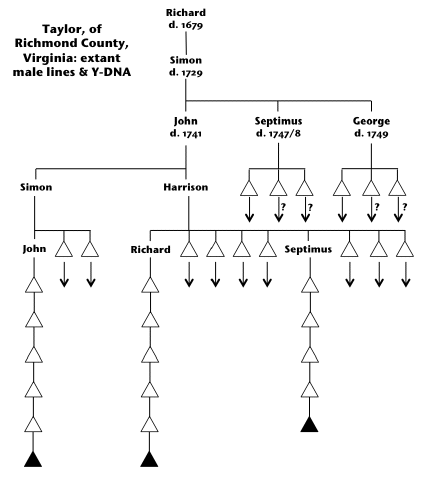I’d been meaning to get into this for a while but had put it off. I’ve tracked my extended male family — on paper — for 17 years now (see my book). But what if DNA testing showed I didn’t belong? Not that I fear skeletons in my closet (or my ancestors’ closets), but I didn’t want the quandary of questioning the value or applicability of something I’d spent so much time on, if it were to turn out I wasn’t actually biologically related. At any rate, others got feet wet first and, following a fifth cousin’s lead (and the persistent prompting of another possible distant kinsman), I signed up for a 37-marker Y-DNA test at familytreedna.com. Results are now in (for me, only partial results at this time), but they prove we are related, and show another Taylor, a seventh cousin, is also (we all share a precise 25-marker profile, and the other two subjects differ in 3 loci in the panel 26 to 37). Depending on what my last 12 markers (not yet back from the lab) show about these three divergent loci, we will hopefully be able to deduce a 37-marker Y-DNA haplotype of our common ancestor, John3 Taylor of Richmond County, Virginia (1703-41). Once other Taylors, descended from John’s brothers, are tested too, we can hopefully then confirm the Y-DNA haplotype for Simon2 Taylor, who must be considered the genetic founder of the family since there is no way to triangulate a non-mutated haplotype for his father, the apparent immigrant, Richard1 Taylor (Richard1 had another son, also named Richard, but the son Richard cannot be shown to have had a family). Here is a chart showing the the early generations of this family which left extant male issue, with lines down to the three subjects already tested (I’m the one in the middle):

John3 Taylor had twelve male-line grandsons who left further male issue. But for John’s brothers Septimus3 and George3, we do not know whether some of their sons left male descendants of their own (hence the question marks): other Taylors show up who may be their sons, but the documentation is too sparse to show it. This is precisely the area in which Y-DNA testing can aid this genealogy, once the haplotype is fully established.
Back to ‘paper genealogy’, the first of a two-part article of mine on the possible English origins of this Taylor family is slated to appear in the next number of The American Genealogist.

One Comment
What does it all mean? Here’s what I just wrote to a cousin (the black triangle on the right, above):
Essentially, we are getting in on the ground floor of a new way of looking at families. But we have to be patient: over the next few years I expect more genetic matches will certainly turn up, and shed new light not only on branches of this family in the US, but on other Taylors (in the UK or in the States) who may be related to us from back before our own first Taylor ancestor came to Virginia.
Because the ‘Taylor’ surname is so common, and comes originally not from a unique person or place, but from an occupation practiced everywhere, most Taylor families are unrelated to each other. In fact there may be as many as hundreds of genetically distinct Taylor families in the English-speaking world–each one descended from a different tailor who began to use his occupation as his surname. Finding more of ‘our’ Taylors will be like needles in a haystack–but that is something that computers and genetic databases will be able to do as curiosity-based genetic testing becomes cheaper and more common.
2 Trackbacks/Pingbacks
[…] tree permits a certain degree of confidence assessing the discrepancies. The chart I put into an earlier post showed the descent of the three test subjects from two sons of John Taylor (d. 1741). Here I […]
[…] news! Following work begun in the summer and already blogged here, and here, we now have another matching DNA sample from another branch of our Taylor family, which pushes the […]
Post a Comment